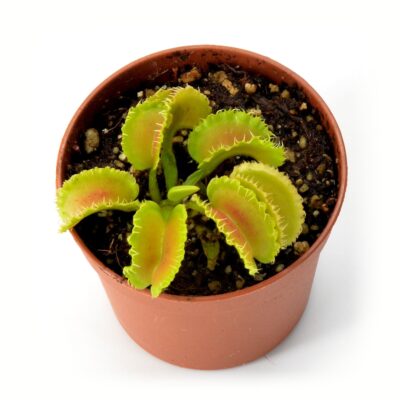Sarracenia (North American Pitcher Plant)
Although very different in shape and size, Sarracenia and Dionaea muscipula share the same natural habitat and require very similar care…
Top-ranked Sarracenia
How to grow Sarracenia North American Pitcher Plant
Although very different in shape and size, Sarracenia and Dionaea muscipula share the same natural habitat and require very similar care. Fortunately, many of the rules seen for Dionaea muscipula also apply to these beautiful carnivorous plants with a very distinctive trap that at first glance may resemble a “trumpet.” The carnivorous leaves of Sarracenia are called “ascidia,” which in some species can exceed one meter in height. At the furthest point of the ascidium and away from the rhizome are the peristome and operculum, which differ in shape and color depending on the various species of Sarracenia. Sarracenia is a carnivorous plant belonging to the family Sarraceniaceae (of which the genera Heliamphora and Darlingtonia are also members) and is native to the southeastern belt of the United States, from Texas to South Carolina. It lives in bogs, “flooded” peat plains constantly soaked with rainwater.
What type of sunlight is best for the growth and health of Sarracenia?
Sarracenia likes full sun all year long! It is possible to shade slightly in the warmer summer months to avoid excessive temperatures that can stunt the plant’s growth. Sarracenia is, however, much less sensitive to heat than Dionaea muscipula
How to water Sarracenia?
3–4 cm of distilled or rainwater is should present in the container where the plant grows. Alternatively, all waters that have an extremely low mineral salt content are suitable. For example, for all condensation water (air conditioner, dehumidifier) conductivity of the water must have a value of fewer than 50 microsiemens.
Why?
Peatlands are ecosystems with an impermeable bottom, mostly clay, that does not allow rainwater to penetrate the lower layers. The result is permanently waterlogged soil that results from the condensation of atmospheric water vapor, which is naturally devoid of mineral salts.
Mineral salts, on the other hand, are commonly found in fresh water and in our aquifers and result from the dissolving of limestones that make up rocks and go into the waters of rivers and lakes. Sarracenia has adapted to grow in an environment devoid of mineral salts derived from water, particularly carbonates, which in the long run would raise the pH of the substrate, irreparably damaging the plant.
Sarracenia likes stagnant water. 3–4 cm of distilled water is always present in the saucer, even in the winter (even if it freezes). This is to faithfully mimic the naturally soupy environment in which they live.
Which substrate should I use for Sarracenia?
50% pure sphagnum peat, 50% perlite
Why?
Sarracenia does not tolerate nutrients. We avoid pH-neutral or nitrogen-amended peats often found in acidophilic potting soils. Peat must be pure. Perlite is an inert substrate that helps aerate the substrate. In nature, there is obviously none, but forced cultivation in small volumes (our pots) requires adaptation to increase the shelf life of the constantly wet substrate.
CAUTION: Do not breathe in unprotected perlite dust; moisturize it properly before handling it; it is very fine dust and harmful to our lungs!
How to care for Sarrecenia in Winter?
Sarracenia is an outdoor plant, even during the coldest months!
Why?
It has evolved to grow in a temperate climate with hot summers and cold winters. It also tolerates subzero temperatures for extended periods if, during the day, the substrate can thaw and the plant can absorb water properly.
What happens during the winter?
In late fall, the leaves dry out. Sarracenia in fact stores energy in an underground stem called the rhizome, which is white in color and lets most of the aerial part die off as the cold weather arrives.
DO NOT BE AFRAID
This is normal. The plant is doing well and should be hydrated with a few inches of distilled water in the saucer as usual, in the same outdoor summer location. In spring, as temperatures rise and light hours increase, the aerial part will sprout again and the plant will begin to vegetate again.
What should you do in the spring?
In spring, temperatures increase, as do the hours of available light. These stimuli are perceived by the plant as the beginning of a new growing season.
Sarracenia’s awakening is characterized by flower growth. In appearance, the flower emerges from the rhizome as a small ball (immediately recognizable compared to the forming leaves, which are instead flat and thin).
Unlike Dionaea muscipula, the Sarracenia flower is nothing short of spectacular. By cutting it off, you gain ascidian vigor, which will begin to grow soon after the flower, but you certainly miss an unusual sight: each flower has its own shade of color, its own smell, and its own bearing.
The decision is up to you!
If you want to fully enjoy all the beauty of this fantastic carnivorous plant, I recommend letting the plant bloom.
If, on the other hand, you want to push ascidian production to the maximum, then you can cut off the flower with a common pair of scissors as soon as it reaches 3–4 cm in height.





























































 Dionaea muscipula "Alpenglow"
Dionaea muscipula "Alpenglow"  Dionaea muscipula "Asmodeus"
Dionaea muscipula "Asmodeus"  Dionaea muscipula "Sly Wiki"
Dionaea muscipula "Sly Wiki"